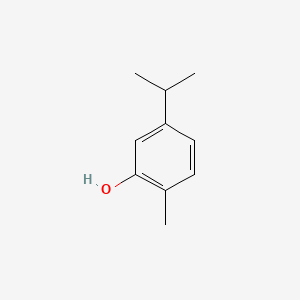Carvacrol
Carvacrol is a lipid of Prenol Lipids (PR) class. Carvacrol is associated with abnormalities such as Consumption-archaic term for TB, Disintegration (morphologic abnormality), Infection, Corn of toe and Candidiasis of vagina. The involved functions are known as Stereochemistry, Anabolism, Oxidation, Process and Binding (Molecular Function). Carvacrol often locates in Skin, Nerve Tissue, Membrane, Endothelium and Plasma membrane. The associated genes with Carvacrol are P4HTM gene, TRPV3 gene, TRPV1 gene, TRPV2 gene and TRPV4 gene. The related lipids are Fatty Acids, Lipopolysaccharides, Octanols, Micelles and butyrate.
References related to locations published in Others
| PMID | Journal | Published Date | Author | Title |
|---|---|---|---|---|
| 19578162 | J. Lipid Res. | 2010 | Hotta M et al. | Carvacrol, a component of thyme oil, activates PPARalpha and gamma and suppresses COX-2 expression. |
| 20086034 | Mol. Pharmacol. | 2010 | Earley S et al. | A dietary agonist of transient receptor potential cation channel V3 elicits endothelium-dependent vasodilation. |
| 26453324 | Am. J. Physiol. Heart Circ. Physiol. | 2015 | Pires PW et al. | Unitary TRPV3 channel Ca2+ influx events elicit endothelium-dependent dilation of cerebral parenchymal arterioles. |
| 24759772 | Neuroscience | 2014 | Klein AH et al. | Eugenol and carvacrol excite first- and second-order trigeminal neurons and enhance their heat-evoked responses. |
| 21131083 | Int. J. Food Microbiol. | 2011 | de Oliveira TL et al. | Antimicrobial activity of Satureja montana L. essential oil against Clostridium perfringens type A inoculated in mortadella-type sausages formulated with different levels of sodium nitrite. |
| 27075912 | J. Nutr. | 2016 | Ran C et al. | Thymol and Carvacrol Affect Hybrid Tilapia through the Combination of Direct Stimulation and an Intestinal Microbiota-Mediated Effect: Insights from a Germ-Free Zebrafish Model. |
| 26346899 | Vet. Parasitol. | 2015 | Novato TP et al. | Evaluation of the combined effect of thymol, carvacrol and (E)-cinnamaldehyde on Amblyomma sculptum (Acari: Ixodidae) and Dermacentor nitens (Acari: Ixodidae) larvae. |
| 26156773 | Proc. Biol. Sci. | 2015 | Patricelli D et al. | Plant defences against ants provide a pathway to social parasitism in butterflies. |
| 26146083 | Cell Rep | 2015 | Peng G et al. | Plant-Derived Tick Repellents Activate the Honey Bee Ectoparasitic Mite TRPA1. |
| 25338672 | Mol. Pharmacol. | 2015 | Lansdell SJ et al. | Activation of human 5-hydroxytryptamine type 3 receptors via an allosteric transmembrane site. |
